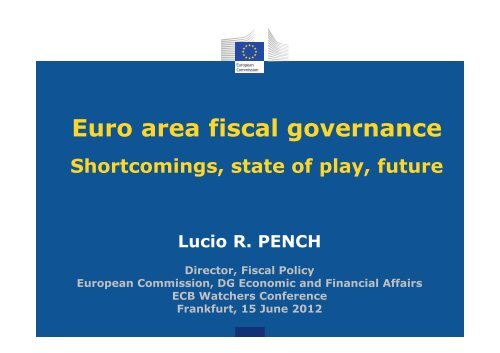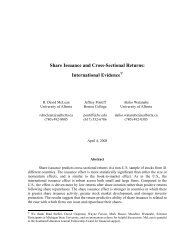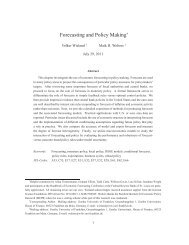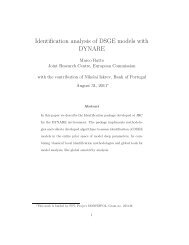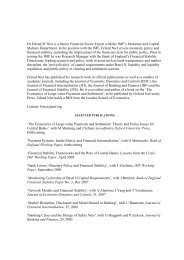You also want an ePaper? Increase the reach of your titles
YUMPU automatically turns print PDFs into web optimized ePapers that Google loves.
Euro area fiscal governance<br />
Shortcomings, state of play, future<br />
<strong>Lucio</strong> R. PENCH<br />
Director, Fiscal Policy<br />
European Commission, DG Economic and Financial Affairs<br />
ECB Watchers Conference<br />
Frankfurt, 15 June 2012
Outline<br />
1. Origins of the crisis<br />
2. Daunting fiscal challenges<br />
3. The fiscal strategy<br />
4. Austerity versus growth<br />
5. Fiscal and external adjustments<br />
6. Fiscal governance: recent reforms<br />
7. Euro area governance: which agenda?<br />
2
Banking crisis triggered dangerous feedback loops<br />
Bank solvency<br />
concerns<br />
More Banking /<br />
Financial Strains<br />
Negative wealth<br />
effect<br />
Tighter financial<br />
conditions index<br />
Reduced loan<br />
supply<br />
Bailout costs<br />
Lower<br />
corporate<br />
profits<br />
Credit losses<br />
Source: Goldman Sachs, Global Economics Weekly 11/38, 30/11/2011<br />
Higher<br />
Government Bond<br />
Yields<br />
Deeper<br />
Recession<br />
Higher debt<br />
service<br />
Calls for fiscal<br />
tightening<br />
Default<br />
worries<br />
Higher<br />
Government Debtto-GDP<br />
Ratio<br />
Lower nominal<br />
GDP<br />
Lower tax<br />
receipts<br />
3
An incomplete institutional set-up<br />
• Imprudent fiscal policies by Member States<br />
• Insufficient EU capability (de facto) to enforce fiscal discipline<br />
• Only weak surveillance tools to address macroeconomic imbalances<br />
• No established sovereign debt crisis resolution mechanism<br />
• No integrated European supervisory and regulatory architecture for<br />
financial institutions<br />
• Fragmented national regulations and supervisory frameworks<br />
• No macro/micro European supervision or resolution authority<br />
���� Strengthened governance<br />
���� Policy response in Member States<br />
4
Public debt in perspective:<br />
The crisis is the same but different<br />
Extract from: Marco Buti, <strong>Lucio</strong> R <strong>Pench</strong>, Fiscal austerity and policy credibility, 20 April 2012, www.voxeu.org<br />
5
12<br />
10<br />
8<br />
6<br />
4<br />
2<br />
0<br />
-2<br />
-4<br />
Large fiscal gaps to ensure medium<br />
to long-run sustainability<br />
S1 (% GDP)<br />
EE IT PL LUDE FI PT EA SI CYATMTFRESNLSKBE EL IE<br />
Source: European Commission.<br />
S1: Adjutsment of structural primary balance by 2020 to revert to 60%GDP debt by 2030.<br />
S2: Adjutsment of structural primary balance to fulfill the intermporal budget constraint.<br />
S1 and S2 based on Commission Spring forecasts and cost of ageing of May 2012 Ageing Report.<br />
12<br />
10<br />
8<br />
6<br />
4<br />
2<br />
0<br />
-2<br />
-4<br />
S2 (% GDP)<br />
IT PT PL DE EE EL FR EA AT ES FI CYMT IE BE SI NL SK LU<br />
6
The exit strategy as set in late 2009<br />
Required fiscal effort EDP deadline<br />
Germany at least 0.5% in 2011-13 2013<br />
The Netherlands 3/4% in 2011-13 2013<br />
Belgium 3/4% in 2010-12 2012<br />
France above 1% in 2010-13 2013<br />
Spain 1.5% in 2010-13 2013<br />
Ireland 9,5% cumulated over 2011-2015 2015<br />
Greece 10% cumulated over 2009-2014 2014<br />
Source: EDP Council recommendations<br />
Selected euro area countries<br />
- Substantial<br />
and spread out<br />
over several<br />
years<br />
- Differentiated<br />
according to<br />
fiscal space<br />
- Focus on<br />
structural effort<br />
- Growth-friendly<br />
composition<br />
7
10<br />
8<br />
6<br />
4<br />
2<br />
0<br />
-2<br />
BE<br />
DE<br />
Differentiated fiscal adjustment:<br />
taken seriously and taking place<br />
EE<br />
IE<br />
Change in headline deficit<br />
2009-2012 (pps.)<br />
EL<br />
ES<br />
FR<br />
IT<br />
CY<br />
LU<br />
MT<br />
NL<br />
AT<br />
PT<br />
SI<br />
SK<br />
FI<br />
EA-17<br />
Source: Commission 2012 Spring Forecast.<br />
14<br />
12<br />
10<br />
8<br />
6<br />
4<br />
2<br />
0<br />
-2<br />
-4<br />
BE<br />
DE<br />
EE<br />
IE<br />
Change in primary structural<br />
balance 2009-2012 (pps.)<br />
EL<br />
ES<br />
FR<br />
IT<br />
CY<br />
LU<br />
MT<br />
NL<br />
AT<br />
PT<br />
SI<br />
SK<br />
FI<br />
EA-17<br />
8
0,0<br />
-0,5<br />
-1,0<br />
-1,5<br />
-2,0<br />
-2,5<br />
-3,0<br />
-3,5<br />
-4,0<br />
-4,5<br />
Fiscal plans: consolidation to continue<br />
Headline deficits (% GDP) Structural deficits (% GDP)<br />
2011 2012 2013 2014 2015<br />
SCPs COM forecasts<br />
Source: Stability programs, Commission 2012 Spring forecasts. Data shown is euro area aggregate.<br />
0,0<br />
-0,5<br />
-1,0<br />
-1,5<br />
-2,0<br />
-2,5<br />
-3,0<br />
-3,5<br />
-4,0<br />
-4,5<br />
2011 2012 2013 2014 2015<br />
SCPs COM forecasts<br />
9
Is the fiscal strategy appropriate?<br />
• Basic principles: steady, differentiated, growth-friendly<br />
• Waiting for growth not credible.<br />
• Fine-tuning adjustment to the business cycle not practical.<br />
• Possible debate over nominal versus structural objectives:<br />
— Nominal approach: clarity of the objectives, clear response to<br />
financing pressure<br />
— Structural approach: steady discretionnary fiscal stance<br />
through ups and downs, avoiding low-quality 'emergency<br />
packages'<br />
���� Broadly appropriate strategy<br />
Possible discussion over the 'details'<br />
10
The Stability and Growth Pact offers flexibility<br />
(It is not 'stupid')<br />
• Multi-year correction possible to reflect starting position<br />
and feasible effort<br />
• 'Structural effort' in the focus of the compliance assessment<br />
• Extension of correction deadline possible if the required<br />
structural effort has been delivered but deadline not being<br />
reached owing to adverse economic developments<br />
• 'Severe economic downturn' in the euro area or the EU:<br />
Further deadline extension irrespective of delivered effort<br />
('general crisis clause' introduced by six-pack)<br />
11
"Perverse debt dynamics"?<br />
• Fiscal multipliers: likely higher in crisis times, although<br />
depending on composition, credibility, and the general<br />
environment<br />
• Perverse debt dynamics possible [debt ratio increasing in<br />
response to consolidation], notably when initial debt ratios are<br />
high.<br />
• However:<br />
— Effect is short-run<br />
— Effect is more pronounced if consolidation is not credible<br />
(higher multiplier, higher borrowing cost)<br />
— Postponing the adjustment only delays the problem and risks<br />
making it worse by triggering adverse market reactions<br />
12
Fiscal multipliers<br />
Value: Fiscal multipliers generally positive in the short-run<br />
depends much on composition (spending vs tax), nature of<br />
consolidation (permanent and perceived as such) and general<br />
environment (monetary stance, financial constraints, slack in the<br />
economy, growth in partner countries)<br />
Medium to long-run multipliers typically null or even negative.<br />
In standard conditions QUEST's composition-balanced multipliers at<br />
0.4-0.7, depending on nature of consolidation. In crisis and with<br />
trade partners consolidating, up to around 0.7-1.2.<br />
Similar to the meta-analysis of Leeper et al. (2011) with government<br />
spending multipliers at 0.6-0.9 in normal times and +/-1.5 if<br />
monetary policy at zero low bound: comparable QUEST multiplier 1.2<br />
VAR estimates often high multipliers: VAR focuses on temporary,<br />
spending multipliers, with a typically higher short-run impact.<br />
13
Are multipliers larger in the current crisis?<br />
Financial constraint<br />
Non-Keynesian wealth effect<br />
on consumption and investment<br />
Monetary policy effect<br />
Inflation and policy rate ≈ 0<br />
Competitiveness effect<br />
⇒ risk premia and highly sensitive<br />
to consolidation<br />
⇒ credibility and interest rate effect<br />
Debt overhang,<br />
impaired financial sector<br />
Multipliers typically higher-than-normal in balance-sheet recessions<br />
(=> consolidation costlier) unless credibility effect trumps all other effects.<br />
� If credibility effect extremely high, "unchanged policy" baseline must be<br />
"nosedive", not "cruising along": cold shower better than drowning.<br />
14
Impact of euro area consolidation with current measures<br />
Discretionary fiscal measures (% of GDP)<br />
Euro area 2012 2013<br />
Consumption taxes 0.4 0.2<br />
Labour taxes 0.3 0.0<br />
Corporate taxes 0.0 0.0<br />
Social security contributions 0.0 0.0<br />
Total revenue 0.7 0.2<br />
Transfers -0.2 -0.3<br />
Consumption expenditure -0.2 -0.1<br />
Gross fixed capital formation -0.2 0.0<br />
Total expenditure -0.5 -0.5<br />
Total balance 1.3 0.7<br />
Note: The tables report incremental changes in the respective revenue<br />
and expenditure categories.<br />
Source: Commission services<br />
Consolidation: permanent measures of 2% of GDP, (almost) equally spread<br />
between higher tax revenue and lower expenditure<br />
Revenue side: 2/3 less distortionary VAT and 1/3 more distortionary labour tax<br />
Expenditure side: 4/5 public consumption and transfers and 1/5 public investment<br />
�Moderate short-run multiplier and limited negative long-run effect<br />
Credibility matters:<br />
� Initial multiplier doubles if measures in 2012 not believed to be permanent (“learning”)<br />
� Falling risk premia (here 50 bp on public and 25 bp on private borrowing) in response to<br />
credible consolidation reduce multiplier (“confidence”)<br />
0<br />
-0.1<br />
-0.2<br />
-0.3<br />
-0.4<br />
-0.5<br />
-0.6<br />
-0.7<br />
-0.8<br />
%<br />
Real GDP - deviation from baseline<br />
2012 2013<br />
Credibility Learning Confidence<br />
15
Frontloading versus gradual consolidation<br />
More gradual consolidation preferable in “normal times” because of nominal<br />
rigidities amplifying output contraction (multiplier ↑) especially in presence of strong<br />
liquidity/borrowing constraints and for measures with strong negative impact on<br />
current disposable income<br />
Real GDP in % of baseline<br />
0<br />
-0.1<br />
-0.2<br />
-0.3<br />
-0.4<br />
-0.5<br />
-0.6<br />
-0.7<br />
Reducing government purchases by 1% of GDP<br />
0 1 2 3 4 5<br />
Note: Frontloading implements the full reduction in year 1, gradual consolidation<br />
speads it equally in 2 steps of 0.5 pp each over years 1 and 2.<br />
year<br />
frontloading gradual<br />
But in “danger zone” frontloading might be necessary to establish credibility to<br />
reduce borrowing costs<br />
16
Determinants<br />
of debt limit<br />
Source: IMF Staff<br />
position note, Fiscal<br />
space, 1 September<br />
2010<br />
Front-loaded fiscal consolidation may still be<br />
the best option in the 'danger zone'<br />
17
External adjustment is taking place<br />
18
Fiscal and external adjustments:<br />
complements rather than substitutes<br />
• Emphasis on fiscal does not reflect ignorance that there is a<br />
wider BoP issue. Rather:<br />
— Sovereign crisis/fiscal challenge is a concern in itself<br />
— Fiscal retrenchment a component of reallocation of resources<br />
underlying external adjustment [cannot rely solely on productivity<br />
or wages]<br />
• Macroeconomic imbalance procedure widens the focus:<br />
— 12 Member States experiencing imbalances (external or internal)<br />
— Adjustment making progress though not always enough<br />
• External adjustment should not be, and is not, one-sided:<br />
— Allowing inflation differentials across the zone<br />
— Making the reforms to spur investment<br />
19
Promoting investment-led growth<br />
• Financial sector balance sheet repair, using ESM if needed to<br />
break sovereign/banking sector link<br />
• Differentiated & growth-friendly fiscal consolidation<br />
• Reform implementation under European Semester<br />
• Single Market Act, Services Directive, 3 rd Energy Package etc.<br />
• Increase in EIB's capital by €10 bn<br />
• Use of risk-sharing instruments (eg project bonds)<br />
• Reprogramming of EU funds<br />
20
Governance changes: an overview<br />
Reform Rationale<br />
European semester Stronger coordination<br />
Six-pack<br />
(EU 27)<br />
(In force since Dec-11)<br />
Two-pack<br />
(Euro area)<br />
Fiscal compact<br />
(25 Contracting Parties)<br />
Early and gradual sanctions Better enforcement<br />
Operationalisation of the debt criterion Focus on debt (not just deficits)<br />
Expenditure benchmark Focus on discretionary action<br />
Macroeconomic imbalance procedure Broaden surveillance<br />
Directive on national fiscal framework Coordination and national ownership<br />
Common budgetary timeline<br />
Examination of draft budgets<br />
Policy coordination, complements the<br />
European semester<br />
Enhanced monitoring Better enforcement<br />
National legislation of agreed fiscal rules<br />
Reverse qualified majority in EDP<br />
decisions<br />
National ownership and political<br />
commitment<br />
Better enforcement<br />
Ex ante coordination of economic reforms Economic policy coordination<br />
21
Strengthening economic governance<br />
Fiscal compact<br />
Fiscal compact<br />
Fiscal compact<br />
Fiscal compact<br />
Fiscal compact<br />
Fiscal compact<br />
Fiscal compact<br />
Fiscal compact<br />
Fiscal compact<br />
Fiscal compact<br />
More effective<br />
preventive arm of SGP<br />
Expenditure benchmark<br />
Better enforcement of<br />
rules<br />
- New Regulation on Sanctions<br />
- New Directive on national<br />
budgetary frameworks<br />
Sound fiscal<br />
policy<br />
Focus on debt<br />
developments<br />
Numerical benchmark in the<br />
corrective arm of the SGP<br />
Prevention and<br />
correction of macro<br />
imbalances<br />
New surveillance<br />
procedure and<br />
possible<br />
sanctions<br />
Macro-prudential<br />
supervision<br />
Balanced<br />
growth<br />
Crisis<br />
Resolution Crisis<br />
Resolution resolution<br />
EFSM/EFSF/<br />
EFSM/EFSF/ ESM<br />
EFSM/EFSF/ ESM<br />
ESM<br />
Structural reform<br />
strategy<br />
Europe 2020<br />
Regulation and<br />
supervision of<br />
financial systems<br />
22
Fiscal integration: what is still missing? (1)<br />
• A top-down approach in coordinating the fiscal stance ?<br />
� Perhaps but not clearly a priority. Current 'own house in order'<br />
approach offers some coordination by preventing unsound<br />
behaviours, with more active coordination possible in severe<br />
circumstances.<br />
• An inter-regional insurance mechanism against idiosyncratic<br />
shocks?<br />
� Some theoretical case for it but practical problems quite challenging<br />
(von Hagen and Wyplosz, 2010). Risk of evolving into the permanent<br />
subsidisation of depressed regions. Little political capital to spend on<br />
this now.<br />
23
Fiscal integration: what is still missing? (2)<br />
• Moving towards the common issuance of sovereign debt?<br />
� Crisis has revealed the potential weakness of sovereigns emitting in a<br />
currency over which they have no direct control when financial<br />
markets depart from fundamentals (de Grauwe, 2011)<br />
� Development of a shared debt instrument could also help reestablishing<br />
a safe asset, improve monetary policy transmission and<br />
raise the prospect of the euro as a reserve currency (Green Paper)<br />
• Reducing the risks to the fiscal commitments posed by contingent<br />
liabilities?<br />
� Contingent liabilities, especially from financial sector, have been and<br />
are at the heart of the crisis. They continue to threaten the good<br />
working of the new fiscal governance<br />
� Moving towards a banking union would help reduce and share these<br />
risks<br />
24
Articulating short and long-term solutions<br />
• Political will and vision needed now<br />
• Some immediate steps in the direction of fiscal and financial<br />
union, combined with a step-wise roadmap towards these<br />
objectives<br />
• Start with the full implementation of the recent governance<br />
changes and needed national reforms<br />
• Mutualisation schemes ultimately to be proportioned to the<br />
level of accepted integration<br />
• Political integration in line with the increased centralisation<br />
25


